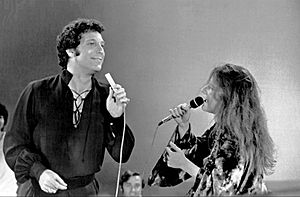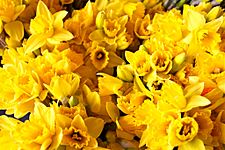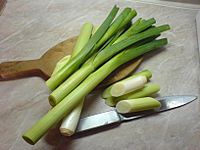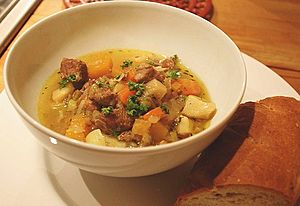Culture of Wales facts for kids
Wales has a special culture with its own language, traditions, holidays, and music.
The main symbol for Wales is the red Welsh Dragon. Other important symbols are the leek and the daffodil. The Welsh words for leeks (cennin) and daffodils (cennin Pedr) are very similar. It's thought that one symbol might have been chosen by mistake for the other, but no one is sure which came first!
Contents
History of Welsh Culture
How Welsh Culture Grew
People have lived in Wales for a very long time, about 230,000 years! We know this because a Neanderthal was found at the Bontnewydd Palaeolithic site in North Wales. But the Welsh rulers from the Middle Ages had the biggest impact on Welsh culture.
In the 800s, Rhodri the Great was the first ruler to control a large part of Wales. Later, in 1055, Gruffydd ap Llywelyn united the Welsh kingdoms. He even started taking over parts of England! Sadly, his own men killed Gruffydd in 1063. This happened just before the Normans invaded England.
The Normans then started to invade Wales. By 1070, they had taken over Gwent and attacked Deheubarth. It seemed like they had conquered Wales by 1093.
But the Welsh people fought back the next year! They took back most of their land from the Normans. Llywelyn the Great became a powerful leader in Gwynedd. He reunited most of Wales by the time he died in 1240. After he died, King Henry III of England tried to stop Llywelyn's son, Dafydd ap Llywelyn, from inheriting his father's lands. This led to war. Later, King Edward I of England conquered Wales.
The Tudors of Penmynydd family became very powerful between the 1200s and 1400s. They lost their land after Maredudd ap Tudur supported Owain Glyndŵr's rebellion in 1400. Maredudd's son, Owain ap Maredudd ap Tudur, changed his name to Owen Tudor. He was the grandfather of Henry Tudor. Henry became King of England after winning the Wars of the Roses. His family, the House of Tudor, ruled until 1603.
Welsh Identity
Welsh people have a strong sense of who they are. This feeling of national pride is called nationalism.
Welsh Symbols
The official symbols of Wales are the Welsh Dragon, the daffodil, and the leek. Both the dragon and the leek have been symbols since the 600s. King Cadwaladr of Gwynedd had his soldiers wear leeks in battle. This helped them tell who was Welsh and who was a Saxon. He also used the Red Dragon flag. This symbol might have come to Britain with Roman soldiers. It could also be from the Welsh word draig, meaning "leader."
The Normans later used the dragon flag. Richard I of England took a red dragon flag with him on the Third Crusade. The colors of the leek were used for soldiers' uniforms under Edward I of England.
The Tudor kings liked both symbols. Henry VII of England added the white and green background to the red dragon flag. Later, the House of Stuart preferred a unicorn instead. By the 1700s, people in Great Britain often wore leeks on St. David's Day. In 1807, a red dragon became the King's badge for Wales. In 1953, people wanted to add a Welsh motto to the flag. But this idea wasn't popular. Six years later, Queen Elizabeth II helped create the flag we see today.
The daffodil became popular as a symbol in the 1800s. It might be linked to the leek because the Welsh word for daffodil, cenhinen Bedr, means "St Peter's Leek." In the 1900s, the daffodil became as important as the leek. Prime Minister David Lloyd George made sure daffodils were part of the ceremony for Edward, Prince of Wales.
The traditional Welsh costume and Welsh hat were well known in the 1800s and early 1900s. Princess Alexandrina Victoria had a hat made for her when she visited Wales in 1832. The hat became famous from Sydney Curnow Vosper's 1908 painting Salem. But by then, people didn't wear the hat as much.
Language
Wales has its own language, Welsh, which is still spoken today. Many people also speak English.
Festivals
The special saint of Wales is Saint David, or Dewi Sant in Welsh. St. David's Day is celebrated on March 1st. Some people think it should be a public holiday in Wales. Other days suggested for national celebrations are September 16th (when Owain Glyndŵr's rebellion started) and December 11th (when Llywelyn ap Gruffudd died).
Traditional Welsh festivals that celebrate the seasons include:
- Calan Gaeaf (like Halloween, on the first day of winter)
- Gwyl Fair y Canhwyllau (Mary's Festival of the Candles, like Candlemas)
- Calan Mai (May Day, similar to Beltane)
- Calan Awst (August 1st, like Lammas)
- Gŵyl Mabsant (a festival for each local saint, often with a fair)
- Dydd Santes Dwynwen (a Welsh version of Valentine's Day)
- Calennig (a Welsh New Year celebration)
Arts in Wales
Visual Arts
Many old Celtic art pieces have been found in Wales. In the early Middle Ages, Welsh Christian art was part of the Insular art style. Some illuminated manuscripts, like the 8th-century Hereford Gospels and Lichfield Gospels, might be from Wales. The 11th-century Ricemarch Psalter is definitely Welsh. It shows a mix of old Insular style with some Viking influences.
Most Welsh artists from the 1500s to 1700s had to leave Wales to find work. But in the 1700s, landscape art became popular in England. This meant artists could stay in Wales to paint its beautiful scenery. It also brought artists from other places to paint in Wales. Richard Wilson (1714–1782) was a very important British landscape painter. He painted many Italian scenes, but also some Welsh ones when he visited from London.

It was hard for artists to make a living in Wales until the 1900s. In 1854, a law helped set up art schools, and the Cardiff School of Art opened in 1865. Even then, many graduates had to leave Wales to work. But Betws-y-Coed became a popular place for artists. Its artist community helped start the Royal Cambrian Academy of Art in 1881.
Some famous Welsh painters, like Augustus John and his sister Gwen John, lived mostly in London and Paris. However, landscape painters like Sir Kyffin Williams and Peter Prendergast lived in Wales most of their lives. Ceri Richards was very involved in the Welsh art scene as a teacher in Cardiff. Many artists have moved to Wales, including Eric Gill and David Jones. Today, lots of different kinds of art are made in Wales.
Ceramics
Historically, pottery was made in three main areas of Wales: south-west Wales, northern Monmouthshire, and the Vale of Glamorgan. Places like Pwllcrochan in Pembrokeshire (which means Crock Pool) show where pottery was made. Old kiln sites have also been found. These were often near clay beds, making it easy to get materials. Buckley and Ewenny became important pottery areas in the 1600s and 1700s.
South Wales had several famous potteries during that time. The Cambrian Pottery (1764–1870), also called "Swansea pottery," tried to copy the style of Wedgwood. Nantgarw Pottery, near Cardiff, made beautiful porcelain from 1813 to 1823. Llanelly Pottery was the last big pottery in South Wales when it closed in 1922.
Theatre
360° panorama of amphitheater at Caerleon.jpg|880px|align-cap=center|A 360° view of the Roman amphitheatre at Caerleon. Plays probably started in Wales after the Romans arrived. There are still parts of a Roman amphitheatre at Caerleon. This would have been used by soldiers from the nearby fortress of Isca Augusta. For a long time after the Romans, theatre in Wales was mostly performed by traveling groups. They sometimes used temporary stages.
The rise of the Puritans in the 1600s and then Methodism in the 1700s caused theatre in Wales to decline. Performances were seen as wrong.
Even so, plays continued at fairs and with a few traveling acting groups. The Savoy Theatre, Monmouth, which is the oldest theatre still open in Wales, was built in the 1800s. Other theatres opened later, like Cardiff's Theatre Royal in 1827. After a fire, a new Theatre Royal opened in 1878. More theatres were built because of competition, like the New Theatre, Cardiff, which opened in 1906.
Music
Wales is often called "the land of song." It's famous for its harp players, male choirs, and solo singers. The main Welsh festival for music and poetry is the yearly National Eisteddfod. The Llangollen International Eisteddfod is similar. It gives singers and musicians from all over the world a chance to perform. Many groups support traditional Welsh music and dance. The Welsh Folk Song Society has published many collections of songs.
Male choirs became popular in the 1800s and are still a big tradition in Wales. These choirs first started as parts of church choirs. They sang popular songs of the time. Many old Welsh choirs still exist today, singing a mix of traditional and popular tunes. Traditional Welsh instruments include the telyn deires (triple harp), fiddle, crwth, and pibgorn (hornpipe). The Cerdd Dant Society promotes a special singing style, mainly through a yearly festival. The BBC National Orchestra of Wales performs in Wales and around the world. The Welsh National Opera is based at the Wales Millennium Centre in Cardiff Bay. The National Youth Orchestra of Wales was the first of its kind in the world.

Wales has produced many successful singers over the years. In the 1960s, bands like Amen Corner and Badfinger were popular. Singers like Sir Tom Jones, Dame Shirley Bassey, and Mary Hopkin also became famous. By the 1980s, indie pop and alternative rock bands like The Alarm were popular. But many people thought the Welsh music scene wasn't as exciting as it used to be.
In the 1990s, the "Britpop" music scene grew in England. In Wales, bands like Catatonia and the Super Furry Animals started singing in English. This led to a big change in Welsh music. The "Cool Cymru" bands became very popular across the UK. The most famous Welsh band during this time was the Manic Street Preachers. Their 1996 album Everything Must Go is considered one of the greatest albums ever.
Some of these bands are still successful today. The popularity of Welsh music also helped older singers like Tom Jones. His album Reload was his first number one album since 1968. Shirley Bassey also had a hit song with the Propellerheads called "History Repeating." New artists like Duffy also emerged. In the 2000s, Bullet for My Valentine was named the Best British Band at the Kerrang! Awards three years in a row. Other successful bands from this time include Funeral For A Friend.
Welsh Food

Some people think Wales doesn't have a strong food identity. They might even say there's "no such thing as Welsh food." Welsh cooking is often thought to be similar to English food. However, there are different foods found across Wales. This is because certain crops and produce were only available in specific areas long ago. The cuisine of Gower is very different from the rest of Wales. It was influenced by Somerset and Devon. They developed dishes like whitepot and used ingredients like pumpkin, which are unusual in other parts of Wales.
Cattle farming is a big part of Wales' agriculture. Welsh beef is protected by law. This means it must be produced and slaughtered in Wales. Welsh pigs are also raised, providing good meat. The mountains in Wales are perfect for sheep farming. This is why lamb and mutton are strongly linked to the country. Welsh mutton has been popular in the UK since the 1500s. By the late 1900s, there were over 11 million sheep in Wales!
Several Welsh dishes are famous because their ingredients are linked to Wales. Others were created there. Cawl is seen as the national dish of Wales. It's a slow-cooked broth with meat and vegetables. It used to have more vegetables, but now it often has beef or lamb. Welsh rarebit is a dish with melted cheese on toast. It's thought to be from the 1700s. The original name "Welsh rabbit" might have been a joke about the Welsh people.
Another dish with cheese is Glamorgan sausage. This is a sausage without a skin, made from cheese and leeks or spring onions. It's rolled into a sausage shape and then fried. Laverbread is made from seaweed puree. It's traditionally served with a Welsh breakfast. Welsh cakes are small, round, spiced cakes cooked on a bakestone. They contain raisins, sultanas, and sometimes currants. Bara brith is a fruit loaf that has similar ingredients to Welsh cakes.
Beer is the national drink of Wales. The Wrexham Lager Beer Company was the first successful lager maker in Britain in 1882. The Felinfoel Brewery was the first in Europe to put beer in cans. Making whisky in Wales used to be a small industry. It stopped completely in 1910. However, the Penderyn distillery started making Welsh whisky again. It was the first Welsh-made whisky to be sold in a century when it launched in 2004. There are also 20 Welsh vineyards that produce about 100,000 bottles of wine each year.
Images for kids
-
Owain Glyndŵr painting by AC Michael.
-
A medieval crwth instrument.











